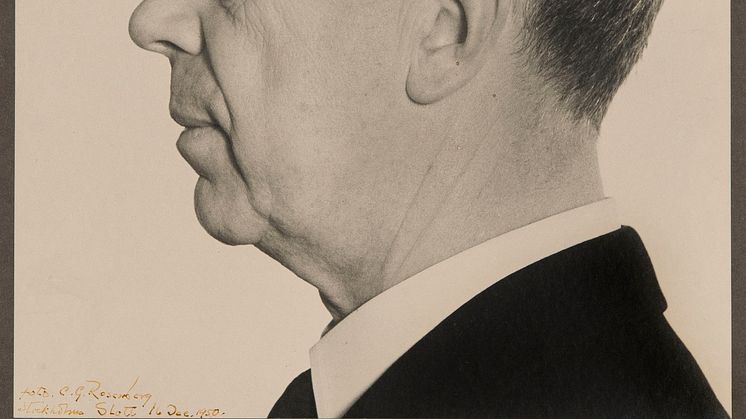
Press release -
New acquisition: Photographic portrait of Gustaf VI Adolf by C.G. Rosenberg
Thanks to a generous donation, Nationalmuseum has acquired a unique photographic portrait by C.G. Rosenberg of King Gustaf VI Adolf. Since ancient times, images of the sovereign in profile have symbolized a nation. This portrait of Gustaf VI Adolf is the most widely circulated image of the king. A version of it remains in daily use in the form of a five-krona coin, which is to be gradually withdrawn from circulation, starting in the autumn of 2016.
Gustaf VI Adolf succeeded his father, Gustaf V, upon the latter’s death on 29 October 1950. The accession of a new monarch means new coinage is required, bearing the image of the new head of state as a symbolic guarantee of value. Such images in profile are among the oldest known examples of official portraits and have changed little from ancient times to the present day.
On 16 December 1950, C.G. (Carl Gustaf) Rosenberg was summoned to the Royal Palace in Stockholm to photograph the new King Gustaf VI Adolf. The result was a stark profile portrait, designed to be used as a master image for coins and stamps. Léo Holmgren, the chief engraver at the Royal Mint of Sweden, used Rosenberg’s photograph as a model for various commemorative coins issued between 1952 and 1972, and for the five-krona piece designed in 1972 and still in circulation today. Likewise, portrait artist David Tägtström and graphic designer Mark Sylwan started from Rosenberg’s photo when they created new postage stamps bearing the king’s image, engraved by Sven Ewert. With minor modifications in the 1960s by Karl-Erik Forsberg and stamp engraver Czeslaw Slania, these stamps were issued in various denominations and colours until 1971.
C.G. Rosenberg was not primarily a portrait photographer, but was known chiefly for his images of nature and architecture. From 1922 to 1955, he was a contributor to the Swedish Tourist Association’s yearbook and, as such, was instrumental in shaping mid-20th-century popular perceptions of Sweden. Admired by many architects of the time, Rosenberg was invited to photograph prestigious projects such as the Stockholm Public Library, the Woodland Cemetery (Skogskyrkogården) in Enskede and the Stockholm Concert Hall. He was also commissioned to photograph heritage buildings and artifacts. Rosenberg contributed to several books on the subject, including one about Swedish castles and manor houses, and a series of prints published by Nationalmuseum in 1921. It may seem surprising that a specialist portrait photographer was not chosen to produce this key image of the new Swedish king, but given Gustaf VI Adolf’s great interest in cultural heritage, art and books, Rosenberg must have been a familiar name to him.
Thanks to Mr Lars Rosenberg’s generous donation of a selection of photographs by his grandfather, C.G. Rosenberg, one of the most widely known images of King Gustav VI Adolf has now been added to The Swedish National Portrait Gallery. Nationalmuseum has no budget of its own for new acquisitions, but relies on gifting and financial support from private funds and foundations to enhance its collections of fine art and craft.
Press contacts
Eva-Lena Karlsson, Curator Collections and The Swedish National Portrait Gallery,
eva-lena.karlsson@nationalmuseum.se, +46 8 5195 4430
Hanna Tottmar, Press Officer, hanna.tottmar@nationalmuseum.se, +46 767 234632
Caption
C. G. Rosenberg, Photographic Portrait of HM King Gustav VI Adolf, 1950. Photo: Anna Danielsson/Nationalmuseum.
Categories
Nationalmuseum is Sweden’s premier museum of art and design. The collections comprise older paintings, sculpture, drawings and graphic art, and applied art and design up to the present day. The museum building is currently under renovation and scheduled to open again in 2018. In the meantime, the museum will continue its activities through collaborations both in Sweden and abroad as well as temporary exhibitions at the Royal Swedish Academy of Fine Arts, Fredsgatan 12 and Nationalmuseum Design at Kulturhuset Stadsteatern in Stockholm. Nationalmuseum has partnerships with Svenska Dagbladet and the Grand Hôtel Stockholm, and acknowledges the support of FCB Fältman & Malmén.

